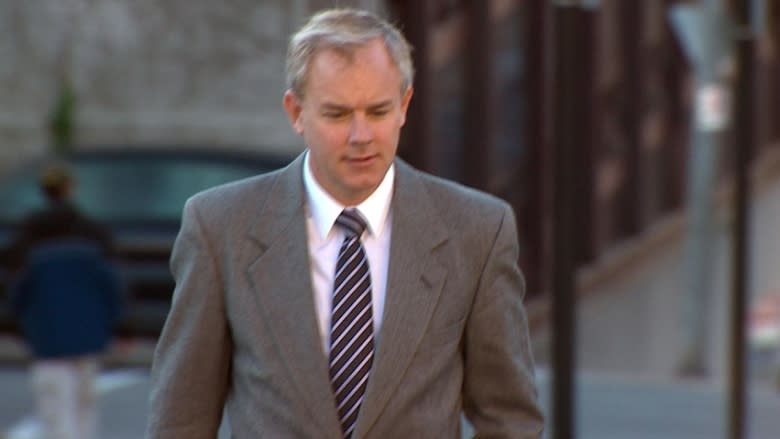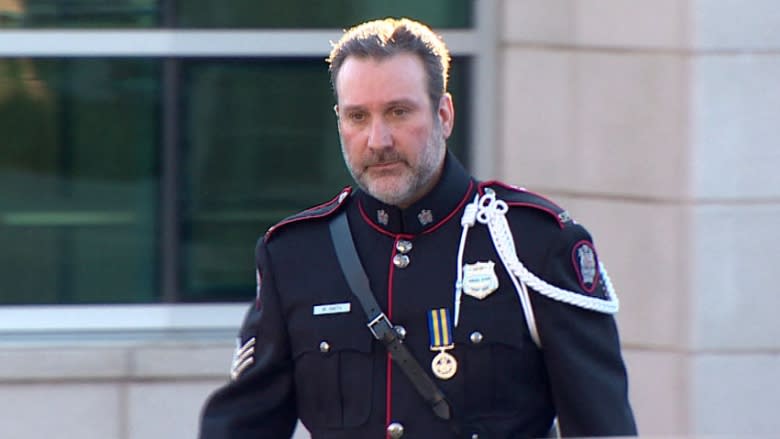Dennis Oland's car, shoes, bag all tested negative for blood, jury hears
Forensic tests of Dennis Oland's car, shoes and a reusable grocery bag he reportedly had with him when he last visited his father at his Saint John office, all came back negative for blood, the jury at his second-degree murder trial heard on Wednesday.
Meanwhile, blood found on a paper towel and in a bathroom sink outside Richard Oland's office was unrelated to the prominent businessman's slaying, the head of the Saint John Police Force's forensic identification unit, confirmed under cross-examination.
Dennis Oland, 47, who was the last known person to see his father alive during a meeting at his investment firm office on July 6, 2011, has pleaded not guilty in his bludgeoning death.
The body of Richard Oland, 69, was discovered in his Far End Corporation office the following morning, lying face down in a large pool of blood.
He had suffered 40 sharp and blunt force injuries to his head and neck and six defensive wounds to his hands.
Sgt. Mark Smith, who has been with the Saint John Police Force for about 27 years, including the past nine as head of the forensic unit, testified it was "one of the bloodiest" crimes scenes of his career, with the most blows to a victim he had ever seen.
Defence lawyer Gary Miller contends Oland's killer would have gotten blood on him or her, given the "hundreds" of blood spatter stains radiating around his body — some up to nine feet away.
Miller grilled Smith on Wednesday about the absence of blood found in his client's car, which was seized by police about a week after Oland's death.
Smith spent about 15 hours examining the Volkswagen Golf City over the course of three days, conducting various tests. It was a "very thorough search," commented Miller.
And while some preliminary tests showed "weak positive results" for the possible presence of blood, further analysis by the RCMP lab in Halifax came back negative.
This, despite the fact that RCMP advised swabs of the car should be among the first items sent for testing because they would likely be the "best and most fruitful" of the more than 500 pieces of evidence gathered, said Miller.
Brown jacket not addressed
Miller suggested if a killer had blood on his or her jacket, for example, and got into a car with fabric seats, there would be a "very good chance" of blood transfer.
"Depending on where the blood was on the jacket," replied Smith.
The Crown has said a brown sports jacket seized from Dennis Oland's bedroom closet with a dry cleaning tag still attached had four areas of blood on it matching Richard Oland's DNA profile.
The accused had told police he was wearing a navy blazer when he went to visit his father, but he was captured on video surveillance wearing a brown jacket, and the victim's secretary also testified to seeing him in a brown jacket.
Miller did not directly address the jacket during his cross-examination of Smith on Wednesday. Smith will be back on the stand Thursday morning for a sixth day of testimony.
6 pairs of shoes tested
Miller did, however, spend a lot of time talking about Dennis Oland's shoes.
Smith had previously testified to finding possible footwear impressions in blood at the crime scene. Miller asked if there was a "reasonable possibility" they would belong to the killer.
"It's possible, yes," Smith replied.
Miller also suggested, given the amount of blood spatter in all directions, it was "reasonable" the killer would also have blood not just on his or her shoe treads, but also on other parts of the shoes. It "could happen," agreed Smith.
Shoes are normally a "fruitful source" for blood evidence, continued Miller, noting blood can get into the laces and stitching. Smith agreed.
But no blood was found on the six pairs of shoes seized from Dennis Oland, including the ones he appears to be wearing in a surveillance video introduced by Miller.
The video was taken at Kent Building Supplies in Saint John on July 7, 2011, around 8 a.m., shortly before Richard Oland's body was discovered.
Smith said the shoes Dennis Oland was wearing in the video appeared to be the same ones he was wearing when he was interviewed by police later that day.
During that statement, Oland told police he was wearing the same shoes the night before when he had visited his father at his office at 52 Canterbury St.
Bag from trunk tested negative
Miller also introduced surveillance video of Canterbury Street, taken on July 6, 2011, at 6:12 p.m., showing a man, who appears to be Dennis Oland, wearing a brown jacket and carrying a red, reusable grocery bag.
Saint John police had seized a red, reusable grocery bag from the trunk of Dennis Oland's car, but RCMP found no blood, confirmed Smith.
Blood found in the bathroom sink and on a paper towel in the bathroom garbage can outside Richard Oland's office was deemed "unconnected to this homicide," said Miller.
Smith confirmed it pre-dated Oland's killing and the DNA was traced to Galen McFadden, who had been helping Oland with a family history project that summer.
Police sought input of O.J. Simpson expert
Miller also revealed that the Saint John Police Force had sought the input of a forensic expert involved in the O.J. Simpson case during its investigation into Oland's death.
Then-chief Bill Reid had directed then-inspector Glen McCloskey to have investigators put together a package of information and photos to send to Dr. Henry Lee.
Smith confirmed that McCloskey had sent an email about the directive regarding Lee, whom Miller described as "the famous American pathologist," who came to notoriety during the O.J. Simpson trial.
The exact nature of what police were seeking from Lee was not disclosed, but Smith said he doesn't believe Lee ever responded.
No weapon was ever found in the Oland case.
Some of his wounds penetrated his skull, the court has heard.
About five of them appeared to have been caused by a hammer-type instrument, Smith has said. They were round, about three centimetres in diameter and had a pattern in them.
The others were incise wounds made by a sharp instrument, which Smith estimates would have been six or seven centimetres in length.



